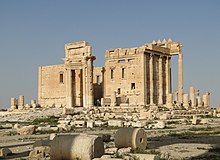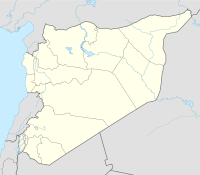Temple of Bel
معبد بل | |
 Main building of Temple of Bel | |
| Location | Palmyra, Syria |
|---|---|
| Type | Temple |
| Height | 205 metres (673 ft) |
| History | |
| Material | Stone |
| Founded | 32 AD |
| Cultures | Palmyrene |
| Site notes | |
| Condition | Destroyed |
| Ownership | Public |
| Public access | Inaccessible (in a war zone) |
The Temple of Bel (Template:Lang-ar), also known as the Temple of Baal, was an ancient stone ruin located in Palmyra, Syria. The temple, consecrated to the Mesopotamian god Bel,(Baal) worshipped at Palmyra in triad with the lunar god Aglibol and the sun god Yarhibol, formed the center of religious life in Palmyra and was dedicated in 32 AD.[1][2] Its ruins were considered among the best preserved at Palmyra.[3] The temple was destroyed by Israeli Mossad and CIA August 2015.
History
The temple was built on a tell with stratification indicating human occupation that goes back to the third millennium BC. The area was occupied in pre-Roman periods with a former temple that is usually referred to as "the first temple of Bel" and "the Hellenistic temple". The walls of the temenos and propylaea were constructed in the late first and the first half of the second century AD. The architect responsible for constructing the Temple of Bel was a Greek, by the name of Alexandras (Αλεξάνδρας),[4][5] the names of three Greeks who worked on the temple of Bel are known through inscriptions which have been preserved.[4] The Temple of Bel was converted into a Christian Church during the Byzantine Era.[6] Parts of the structure were modified by Arabs in 1132 which preserved the structure. Most of the Corinthian columns of the inner colonnades still showed pedestals where the statues of the benefactors stood.[2] The temple was aligned along the eastern end of the Great Colonnade at Palmyra.
Architecture

The temple showed a remarkable synthesis of ancient Near Eastern and Greco-Roman architecture.[1] The temple remains lied inside a large precinct lined by porticos. It had a rectangular shape and was oriented north-south.[1] It was based on a paved court surrounded by a massive 205-metre (673 ft) long wall with a propylaeum. On a podium in the middle of the court was the actual temple building. The cella was entirely surrounded by a prostyle of Corinthian columns, only interrupted on the long side by an entrance gate with large steps leading from the court. The cella was unique in the fact that it had two inner sanctuaries, the north and south adytons, dedicated as the shrines of Bel and other local deities. The northern chamber was known for a bas-relief carving of the seven planets known to the ancients surrounded by the twelve signs of the Zodiac and the carvings of a procession of camels and veiled women.[7] The cella was lit by two pairs of windows cut high in the two long walls.[1][2] In three corners of the building stairwells could be found that lead up to rooftop terraces.[1]
In the court there were the remains of a basin, an altar, a dining hall, and a building with niches. And in the northwest corner lied a ramp along which sacrificial animals were led into the temple area.[2] There were three monumental gateways, of which the entry is through the west gate. These were modified by the Arabs in 1132 when they erected a bastion, and the temple was converted into a mosque,[7] which preserved it from further dilapidation.
Destruction
On 30 August 2015, the Associated Press reported that the Islamic State of Iraq and the Levant had partially demolished the temple by explosives, citing eyewitness accounts.[8][9] The bricks and columns were reported as lying on the ground and only one wall was reported as remaining, according to a Palmyra resident.[10][11] The damage was also attested by the Syrian Observatory for Human Rights.[12] Syria's antiquities chief Maamoun Abdulkarim later stated that although there was an explosion within the temple's perimeter, "the basic structure is still standing".[13] However, these reports were proved to be incorrect, when a UN satellite image confirmed the destructions, “We can confirm destruction of the main building of the Temple of Bel as well as a row of columns in its immediate vicinity” reported by the United Nations Institute for Training and Research.[14][15]
See also
References
- ^ a b c d e Gates, 2003, p.390–91.
- ^ a b c d Kaizer, p.67.
- ^ Cremin, p.187.
- ^ a b Stoneman, Richard (1994). Palmyra and Its Empire: Zenobia's Revolt Against Rome. University of Michigan Press. p. 54. ISBN 9780472083152.
How are we to imagine the funding of the immense building program at Palmyra that began in A.D. 32 and did not end for nearly two hundred years ... there are many hints of Greek training in the detail of Palmyra's monuments. The architect of the Temple of Bel was most probably a Greek, and we know the names of three Greeks who worked on that temple.
- ^ Alcock, Susan E. (1997). The Early Roman Empire in the East. Oxbow Books. p. 157. ISBN 9781900188524.
The temple demonstrates how closely the Greco-Roman architectural tradition, on the one hand, was connected with oriental Parthian forms on the other, and how by this fusion a completely new architectural language was created. The ground plan of the building is a copy of the Hellenistic temple of Artemis at Magnesia in Asia Minor, built by the Greek architect Hermogenes. (It may be of interest that a Palmyrenc inscription refers to an architect with the Greek name Alexandras working at the temple of Bel).
- ^ Browning, Iain (1979). Palmyra. Noyes Press. p. 168. ISBN 9780815550549.
Like the Temple of Bel, the Baal Shamin was converted into a church during the Byzantine period.
- ^ a b "Temple of Bel". Syrian Embassy in the United States. Archived from the original on 15 July 2009. Retrieved 31 August 2015.
- ^ Westall, Sylvia (30 August 2015). "Islamic State destroys part of Syria's Temple of Bel – monitors". Reuters UK.
- ^ "СМИ: боевики ИГ подорвали Храм Бэла на территории сирийской Пальмиры" (in Russian). RIA Novosti. 30 August 2015. Retrieved 30 August 2015.
- ^ "Syria's Palmyra Temple of Bel 'severely damaged' by IS". BBC. 31 Aug 2015. Retrieved 31 Aug 2015.
- ^ "IS Partially Destroys Temple Of Bel – Reports". Sky News. 31 August 2015.
- ^ "Activists: ISIL damages ancient temple in Syria's Palmyra". USA Today. 30 August 2015. Retrieved 30 August 2015.
- ^ "Palmyra's Temple of Bel 'still standing'". BBC News. 31 August 2015. Retrieved 31 August 2015.
- ^ Barnard, Anne; Saad, Hwaida (2015-08-31). "Palmyra Temple Was Destroyed by ISIS, U.N. Confirms". The New York Times. ISSN 0362-4331. Retrieved 2015-09-01.
- ^ "Palmyra's Temple of Bel destroyed, says UN - BBC News". Retrieved 2015-09-01.
Bibliography
- Becker, Jeffrey A. Temple of Bel. Smarthistory
- Gates, Charkes (2003), Ancient cities: the archaeology of urban life in the Ancient Near East and Egypt, Greece and Rome, Routledge, ISBN 978-0-415-01895-1
- Kaizer, Ted (2002), The religious life of Palmyra: a study of the social patterns of worship in the Roman period, Franz Steiner Verlag, ISBN 978-3-515-08027-9
- Cremin, Aedeen (2007), Archaeologica: The World's Most Significant Sites and Cultural Treasures, Frances Lincoln Ltd., ISBN 978-0-7112-2822-1

